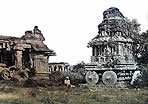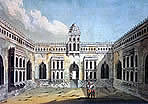| Discovering Vijayanagara |
| |
||||||||||||||||||||||||||||||||||||||||||||||
| In the years after 1565, when Vijayanagara was reduced to a heap of uninhabitable ruins, the region was subjected to repeated invasions. This part of Karnataka was contested between the later sultans of the Deccan, followed by the Maratha invaders and then Haidar Ali and Tipu Sultan of Mysore. Only at the very end of the eighteenth century, when the site formed part of the territories ceded to the Madras Presidency, under the control of the East India Company, did some measure of peace return to the area. Worship in the Virupaksha Temple at Hampi must have then resumed at this time because the shrine was thoroughly renovated with the repair of the entrance gopura and the refurbishment of the ceiling paintings inside. During this period the memory of Vijayanagara endured somehow. In 1799 the first British antiquarian, Colin Mackenzie, the future Surveyor General of India, visited the ruins, collected some manuscripts, had some watercolours painted of monuments and made the first map of the site. Though his report was never published, the site continued to be known, since during the course of the nineteenth century there was a steady flow of visitors, including the first photographers in the 1850s and 1860s. Among these were Alexander Greenlaw, whose 60 or so waxed-paper negatives from 1856 have miraculously survived. These masterpieces of early photography show the site before any clearing work took place. As their interest in local antiquities grew among India’s foreign rulers, efforts were made on the part of local authorities to study and preserve the ruins. As a result, they were eventually came under the protection of the Archaeological Survey of India, the officers of which began to clear and repair the various structures. After the publication of A Forgotten Empire by Sewell, the Collector of Bellary District in which the site was now situated, interest in Vijayanagara gained strength and the site was much improved with access roads, sign boards and a local bungalow to stay in.
Yet Vijayanagara remained a remote site and there were never too many
visitors, even after the appearance of Hampi
Ruins: Described and Illustrated
written by the archaeologists, A. H. Longhurst, that appeared in 1925,
and is still in print. Work at Vijayanagara accelerated only in the
late 1970s under a National Project that stimulated further clearing
work and extensive excavation of the palace area by central and state
archaeologists. These activities were fully under way when the Vijayanagara
Research Project first began work at the site in 1980, and they continue
to the present day under the direction of the Archaeological Survey
of India and the Karnataka Government Directorate of Archaeology and
Museums.
For a history of the European discovery of Vijayanagara link to Michell, 1985, '‘A Never Forgotten City'’. For the work of early photographers at the capital see Michell 2008, Splendour in Ruins; for reports of recent archaeological work at the site by the Archaeological Survey of India, 1955-present, see Indian Archaeology, a Review and by the Karnataka Department of Archaeology and Museum, see Nagaraja Rao, 1979 to 1984, and Devaraj and Patil, 1984 to 1991, Vijayanagara: Progress of Research series; for a summary of texts found at the site, see Patil and Patil 1995, Inscriptions at Vijayanagara (Hampi); all in Bibliography. |
|
|||||


